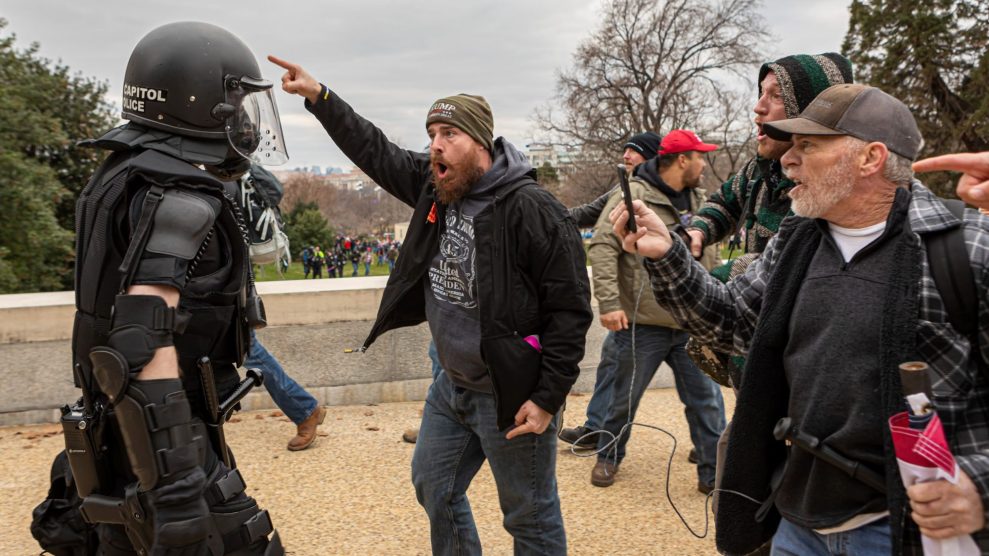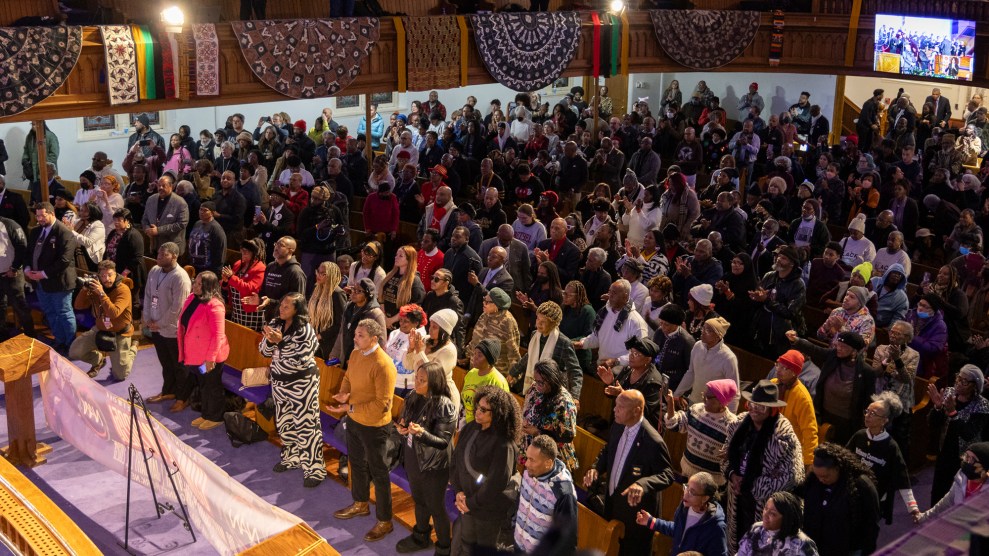Just before Christmas, two of the world’s most venerable legislative bodies engaged in erudite, impassioned debate over what the right balance should be between the imperatives of national security and international prohibitions on torture. They arrived at starkly divergent conclusions that reveal the depth of damage the war on terror is doing to this country’s civil liberties.
On December 7, the House of Lords, reviewing cases in which a dozen Muslim militants were to be deported, spoke with moral clarity on the issue of torture, branding it “an unqualified evil” which should have no place in the proud, thousand-year tradition of British justice. Just a week later, the U.S. Senate amended the Defense Appropriations Bill to prohibit the “abuse” of detainees in American custody, including the many Muslims at our Guantanamo prison, but did so on the purely pragmatic, almost amoral grounds that it “leads to bad intelligence.” Under pressure from the White House, the senators also loaded this legislation with loopholes that may soon allow coerced testimony — extracted through torture — into American courts for the first time in two centuries.
This disconcerting contrast is but one sign that, under the Bush administration, the United States is moving to publicly legitimate the use of torture, even to the point of twisting this congressional ban on inhumane interrogation in ways that could ultimately legalize such acts. And following their President’s lead, the American people seem to be developing a tolerance, even a taste, for torture.
This country may, in fact, be undergoing an historic shift with profound implications for America’s international standing. It seems to be moving from the wide-ranging but highly secretive tortures wielded by the Central Intelligence Agency during the Cold War decades to an open, even proud use of coercive interrogation as a formal weapon in the arsenal of American power, acceptable both to U.S. courts and the American people.
In the early years of its war on terror, the administration maintained the long-standing yet informal executive policy of ordering clandestine CIA torture in times of crisis. Minutes after his public address to a shaken nation on September 11, 2001, President Bush barked to his aides, “I don’t care what the international lawyers say, we are going to kick some ass.”
As administration lawyers translated these words into formal directives, they carefully cloaked this otherwise unlawful demand in three controversial constitutional arguments — that the president’s commander-in-chief powers allow him to override all laws and treaties; that U.S. anti-torture laws can be stretched to provide a winning legal defense for any CIA interrogator accused of torture; and most tenuously of all, that the detainee prison at Guantanamo Bay in Cuba was not on American territory and so was beyond the writ of U.S. courts.
Two years later, when the infamous photos from Iraq’s Abu Ghraib prison exposed the administration’s illegal interrogation tactics in lurid color, the White House was faced with an historic choice that, in practice, proved no choice at all: either definitively ban torture or defy the international community by promoting the practice.
Bartering Away Legal Birthrights
That the upper deliberative bodies of the United States and Great Britain found themselves facing the question of torture at exactly the same moment had a certain ironic appropriateness. After all, the two countries share a secret history of torture reaching back to the dark early days of the Cold War. In 1951, these two nations collaborated in a covert CIA-run mind-control research project into which the American government ultimately poured several billion dollars. Late in that decade, CIA scientists elaborated that research into a revolutionary new form of torture, more psychological than physical, that would prove both legally elusive and highly destructive to the human psyche.
Even though this “no-touch” psychological form of torture generally did greater lasting damage than its physical variant, it was surrounded by an appealing scientific aura and was, at least in theory, devoid of the obvious signs of brutality that might trouble the public and provide telling evidence for prosecutors.
For the next 20 years, Washington deployed these torture techniques against communists and other revolutionaries in Asia and Latin America. Simultaneously, London used them to fight nationalists in its far-flung territories during the long, bloody eclipse of the British empire — in places like Aden, Brunei, British Guiana, and Northern Ireland.
In 1978, charged before the European Court of Human Rights with torturing IRA suspects, Britain swore “a solemn undertaking” that it would never again deploy these psychological torture techniques. Last month, in reversing the deportations of Muslims convicted on “evidence procured by torture inflicted by foreign officials,” London’s law lords cited this case in ruling that “bedrock moral principle” from centuries of common law and recent international conventions made torture anathema in the country’s courts.
By contrast, confronted with strong evidence of detainee abuse at Abu Ghraib and Guantanamo, the Bush White House has fought back by defending torture as a presidential prerogative and so precipitating an epic political struggle in this country. As a powerfully symbolic state practice, synonymous with brutal autocrats, torture, even of the few, raises profound moral and legal questions about the limits of presidential power, the quality of our justice, and ultimately the character of this American civilization.
While the Bush White House has protected and promoted senior officials implicated in the torture scandal, an ad hoc civil-society coalition of courts, media, and human rights groups has mobilized to stop the abuse. In June 2004, the Supreme Court ruled in a landmark case, Rasul v. Bush, that the Guantanamo detainees were indeed on U.S. territory, no matter what the administration’s lawyers claimed, and so deserved access to American courts. This decision prompted some of the country’s top law firms, working pro bono, to file 160 habeas corpus cases on behalf of some 300 Guantanamo detainees.
Last summer, Senator John McCain proposed an amendment to the must-pass Defense Appropriation Bill that would ban all “cruel, inhumane and degrading” treatment of detainees and set the U.S. Army Field Manual as the standard for any interrogation, whether by the military or the CIA. President Bush reacted by vowing to veto the bill, should it somehow pass the Republican-controlled Congress.
When Bush’s bluff failed, the White House began lobbying for the insertion of loopholes into the proposed prohibition. First, Vice President Cheney pressed McCain to exempt the CIA from his ban. The senator refused. Next, National Security Adviser Stephen Hadley weighed in, urging broad legal exemptions for CIA torturers. Again, the senator stood his ground. Suddenly, Secretary of Defense Donald Rumsfeld’s Pentagon rewrote the Army Field Manual to teach interrogators, as the New York Times reported, “how to walk right up to the line between legal and illegal interrogation” — changes one Defense official termed “a stick in McCain’s eye.”
To placate the White House, McCain eventually softened his prohibition by adding a legal defense for accused CIA and military interrogators that mimes the extreme exculpatory logic of the Justice Department’s notorious August 2002 Bybee memo. Drafted to protect CIA interrogators after 9/11, this now-disavowed document argued that torture, as defined under U.S. law, required that the suffering inflicted “be equivalent in intensity to the pain accompanying serious physical injury, such as organ failure, impairment of bodily function, or even death.” In a section of McCain’s amendment called “Protection of United States Government Personnel,” the final legislation opened a little noticed but similarly cavernous legal loophole for future torturers. It allowed U.S. officials “engaging in specific operational practices that involve interrogation of aliens” to claim, if charged, that they “did not know that the practices [they used] were unlawful.”
After the Senate passed McCain’s torture ban by a resounding 90-9 vote, ending any hope of a presidential veto, the administration tried to further neutralize its impact by backing an amendment authored by Republican Senator Lindsey Graham of South Carolina. As originally drafted, this amendment would have allowed the courts to consider all evidence collected under any but the most outrageous uses of “undue coercion.” No less startlingly, it denied detainees in places like Guantanamo — those “unlawful combatants” – any right to challenge their detention by filing writs of habeas corpus in U.S. courts. Complaining that “Non-Citizen Terrorists” at Guantanamo were filing cases over “the quality of their food,” Graham urged passage of his amendment to spare “our troops fighting in the War on Terror” from being “sued in every court in the land by our enemies.” For a mess of partisan pottage, the senator was bartering away this nation’s constitutional birthright of habeas corpus, a foundational legal protection born of Parliament’s long struggle to ban royal torture writs by the infamous Court of Star Chamber.
After the Senate approved Graham’s amendment by a 49-42 vote on November 10, reformers led by Democratic Senator Carl Levin fought an uphill battle to moderate these extreme proposals — replacing the bill’s blanket acceptance of “coerced” evidence with ground rules for its evaluation by the courts and trying to limit the ban on habeas corpus appeals from Guantanamo to future cases, allowing those already filed to proceed.
But in the final legislation, titled “The Detainee Treatment Act of 2005,” McCain’s now-compromised ban on cruel treatment of detainees was effectively eviscerated by Graham’s denial of legal redress. To nullify the landmark Supreme Court ruling that Guantanamo is, in fact, American territory and so falls under the purview of U.S. courts, Graham also stipulated in the final legislation that “the term ‘United States,’ when used in a geographic sense, does not include the United States Naval Station, Guantanamo Bay.” In this way, he tried once again to deny detainees any legal basis for access to the courts. In effect, McCain’s motion more or less bans torture, but Graham’s removes any real mechanism for enforcing such a ban.
The Media Mirage of a Torture Ban
Last December 15, all these tensions seemed to dissolve in a dramatic Oval Office handshake between Senator McCain and President Bush who announced that the landmark legislation made it “clear to the world that this government does not torture.”
That White House photo-op was, however, a complete media mirage. Within hours, the administration began moving deftly to pull any teeth left in this legislation. Speaking to CNN, Attorney General Antonio Gonzales quickly dismissed McCain’s reform as insignificant, insisting that existing legislation only banned the infliction of “severe” physical or psychological pain in interrogations — the same linguistic legerdemain that had allowed the administration to start torturing back in 2002. The attorney general seemed to be echoing the opinions of his subordinates who, according to the Washington Post, were already arguing that the McCain amendment would, “under certain circumstances,” still allow “waterboarding” — the same method that the French Inquisition had once called the “question de l’eau” (water question) or “torturae Gallicae ordinariae” (standard Gallic torture) — and other harsh techniques.
On December 30, right after signing a defense bill that included the McCain amendment at his Crawford ranch, President Bush issued a “signing statement” — carefully released at the extremely unnewsworthy hour of 8:00 pm that Friday night — insisting that his powers as commander-in-chief and head of the “unitary executive branch” still allowed him to do whatever was necessary to defend America. So much for McCain’s efforts as the year ended.
Just four days into 2006, Senator McCain, though claiming confidence that the “President understands Congress’s intent” in passing the torture ban, promised “strict oversight to monitor the Administration’s implementation of the new law.” Faced with nullification by the presidential signing statement, Senator Edward Kennedy warned, during Judge Alito’s confirmation hearings, that President Bush was insisting “whatever the law of the land might be, whatever Congress might have written, the executive branch has the right to authorize torture without fear of judicial review.”
As if to confirm this pessimistic view, the administration quickly deployed the new Detainee Treatment Act to quash any judicial oversight of its actions — particularly the dubious designation of detainees as “unlawful enemy combatants” unworthy of any protection by the Geneva Conventions or the U.S. Constitution.
On January 3, the Justice Department, citing this new law, notified federal judges that it would soon seek the immediate dismissal of all 160 habeas corpus cases already filed for 300 Guantanamo detainees. On January 12, the Solicitor General, again citing the new law, told the Supreme Court it no longer had jurisdiction over Guantanamo and asked the justices to dismiss another potential landmark “unlawful combatant” case, Hamdan v. Rumsfeld. Then, putting the cherry atop the administration’s many-layered legal confection, on January 24 the Army changed its standing orders to allow military executions at Guantanamo, thus keeping the U.S. courts from intervening in any drum-head death sentences for detainees.
All these maneuvers were part of a White House campaign essentially aimed at formalizing those three dubious legal doctrines that had long underpinned its torture policy. Recoiling from the prospect of an “Imperial Presidency” implicit in these moves, the New York Times of January 15 called on Congress “to curtail Mr. Bush’s expansion of power” and his “unilateral rewriting of more than 200 years of tradition and law.”
Looking through a glass darkly into the future, the possible implications of these trends for the quality of American justice are troubling indeed. The military tribunals at Guantanamo are not required to reveal the sources of their evidence against the 500 detainees on trial, even though significant parts of it undoubtedly come from torture and abuse of either the accused or other detainees. Moreover, under the Detainee Treatment Act, federal courts will be able to consider the use of this same coerced information in hearing any appeals from Guantanamo. In a sharp, sad contrast with Britain’s law lords, our congressional legislation allows the courts to weigh the probative value of tortured testimony, potentially introducing coerced evidence into the federal courts for the first time in our nation’s history.
One question seldom asked is: Why has the public response to issues that cut to the very core of America’s national identity been so muted? The short answer: The administration’s increasingly unapologetic advocacy of torture has echoed subtly but effectively with the trauma of 9/11.
With the horrific reality of the Twin Towers attack still resonating and endless nuclear-bomb-in-Times-Square/ticking-bomb interrogation scenarios ricocheting around the media and pop culture, torture seems to have gained an eerie emotional traction. Polls taken over the last three years have confirmed this. With a complex reality reduced to a few terrifyingly simple, fantasy-ridden scenarios, torture in defense of the “homeland” has gained surprisingly wide acceptance, while the torture debate has been reframed — to the administration’s great advantage — as a choice between public safety and the lives of millions or private morality and bleeding-heart qualms over a few slaps up the side of the head. In this way, old-fashioned morality has been made to seem little short of immoral.
Through the invisible tendrils that tie a state to its society, the media has often reflected aspects of administration policy on such subjects. Television, in particular, has had a powerful effect in its repeated portrayals of harsh, even abusive interrogations as effective and morally justified acts –when, in fact, they are neither. After years of watching television shows such as “NYPD Blue” and “24” with plots that mimic the ticking-bomb scenario, millions of ordinary Americans seem to believe that we have entered an era when abuse, or even torture, is necessary to save lives.
Each week, for instance, up to 20 million Americans have watched the fictional detectives of “NYPD Blue” use harsh methods to “tune up” suspects in the “pokey,'” or interrogation room, risking their careers to extract information that regularly saved lives and made the city safer. Accepting the need to torture just one criminal in this week’s episode, or just one terrorist with a ticking bomb in Fox Television’s popular CIA drama “24,” opens ordinary Americans to consider whether the torture of real terrorists is not only justifiable but imperative. It seems likely that these televised scenarios have lent a hand in creating a public climate tolerant of governmental torture.
Does Bush administration policy really reflect a fundamental shift in moral choices by the American public? Have we really developed a taste for torture?
As a people, we are now faced with a decision that will influence the character of our nation and its reputation in the eyes of the world. We can agree with the Bush administration’s decision to make torture a permanent weapon in the American arsenal — or we can reject this policy and join the international community by honoring our commitments under the UN convention, as well as under U.S. law, and banning torture unconditionally.
Alfred W. McCoy is the author of A Question of Torture: CIA Interrogation, from the Cold War to the War on Terror (Metropolitan Books, The American Empire Project, 2006) and a professor of history at the University of Wisconsin-Madison.
Copyright 2006 Alfred W. McCoy
This article appeared first, with an introduction by Tom Engelhardt, at Tomdispatch.com.
















